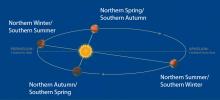Listen to today's episode of StarDate on the web the same day it airs in high-quality streaming audio without any extra ads or announcements. Choose a $8 one-month pass, or listen every day for a year for just $30.
You are here
More Moon and Venus
Until Nicolaus Copernicus demonstrated otherwise, most people thought Earth was the center of the universe. And that wasn’t an unreasonable idea. The Sun, Moon, and stars all appear to circle around us, so it looks like we’re right in the middle of things.
The only problem was the planets. Some of them periodically reverse direction across the sky. And Venus and Mercury don’t go all the way across the sky. They climb part of the way into the morning sky, then double back into the evening sky. That’s hard to explain if everything is circling around Earth.
The explanation, of course, is that they don’t circle around Earth — and neither does anything else except the Moon. The planets all orbit the Sun. Some of them are outside Earth’s orbit, so they swing all the way across the sky. But Mercury and Venus lie inside Earth’s orbit, so they have a limited motion across the sky.
And in fact, Venus is at the limit of that motion over the next few nights. It’s farthest from the Sun for its current “evening star” appearance — about 45 degrees. By the end of the week, it’ll start sliding toward the Sun.
Because of the angle at which Venus sets at this time of year, though, it doesn’t look very far from the Sun. It’s quite low in the west as night falls; tonight, it’s below the crescent Moon. The planet doesn’t drop straight down toward the horizon. Instead, it slides along the horizon as it descends — a world that orbits the Sun, not Earth.
Script by Damond Benningfield






